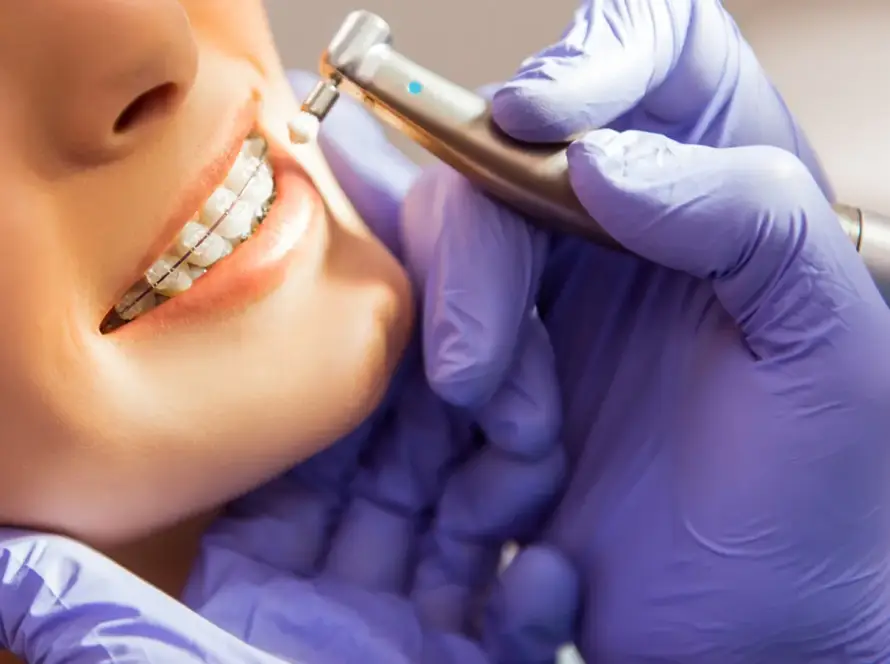Teeth shaving, also known as enameloplasty or odontoplasty, is a dental procedure that involves the removal of a small amount of tooth enamel. This technique is commonly used to reshape teeth, correct minor imperfections, and create a more balanced and aesthetic smile.
Teeth shaving is a conservative dental treatment that is typically performed without the need for anesthesia. It is a quick and painless procedure that involves the use of a dental handpiece with a special burr to carefully remove small amounts of enamel from the tooth surface.
This procedure is commonly recommended for patients who have slightly overlapping or uneven teeth, small chips or cracks, or teeth that appear longer than others due to wear. Teeth shaving can also be performed to reduce the size of pointed or excessively sharp teeth.
By gently reshaping the teeth, teeth shaving can improve the overall appearance of the smile and create a more harmonious and balanced look. It can also help to achieve better oral hygiene by eliminating areas where plaque and bacteria can accumulate.
It is important to note that teeth shaving is a permanent procedure, as once enamel is removed, it cannot grow back. Therefore, it is important to consult with a dental professional to determine if teeth shaving is the right option for your specific dental needs.
In the following sections, we will delve into the process of teeth shaving, discuss the benefits and risks, and provide additional information to help you make an informed decision about this dental treatment.
Teeth Shaving
Teeth shaving, also known as enameloplasty or tooth contouring, is a dental procedure that involves the removal of small amounts of tooth enamel to reshape the teeth. It is commonly done to correct minor cosmetic issues or to improve the overall appearance of the teeth. Here is a step by step overview of the teeth shaving procedure:
- Evaluation and Consultation: Before undergoing teeth shaving, a comprehensive dental examination is carried out by a dentist. This evaluation helps determine if the procedure is suitable for the patient’s specific dental concerns.
- X-Rays: In some cases, X-rays may be taken to assess the condition of the teeth and underlying structures. This helps the dentist to plan the procedure effectively and ensure there are no underlying issues that may affect the outcome.
- Local Anesthesia: To ensure a comfortable experience, the dentist will administer a local anesthetic to numb the area being treated. This helps to minimize any potential discomfort.
- Shaping the Teeth: Using a dental drill or laser, the dentist carefully removes small amounts of enamel from the targeted areas. The aim is to reshape the teeth and create a more aesthetically pleasing appearance. The amount of enamel removed is typically minimal, usually around fractions of a millimeter.
- Smoothing and Polishing: After reshaping the teeth, the dentist will use polishing instruments to smooth the surface and provide a natural looking finish. This step helps to eliminate any rough edges and give the teeth a polished appearance.
- Oral Care Instructions: Following the procedure, the dentist will provide instructions on how to care for the teeth. This may include recommendations for regular brushing, flossing, and maintaining good oral hygiene practices.
Teeth shaving is generally considered a safe procedure with minimal risks and complications. However, it is important to note that it may not be suitable for all dental conditions. Dentists will assess each case individually to determine the best treatment option for their patients.
Benefits of Teeth Shaving
Teeth shaving, also known as enameloplasty or enamel reduction, offers several benefits for individuals seeking to improve their dental health and enhance their smile. Here are the key advantages of this procedure:
- Improved aesthetic appeal: Teeth shaving can effectively reshape and contour teeth to create a more harmonious and balanced smile. By removing excessive enamel, dentists can correct uneven or misaligned teeth, resulting in a more attractive appearance.
- Enhanced oral hygiene: Irregular or overcrowded teeth can be challenging to clean properly, leading to plaque buildup and increased risk of dental issues like cavities and gum disease. By shaving minor imperfections, it becomes easier to maintain good oral hygiene and prevent potential dental problems.
- Reduced tooth sensitivity: Enameloplasty can benefit individuals with sensitive teeth. By smoothing out rough or uneven surfaces, teeth shaving reduces the risk of tooth sensitivity caused by exposed dentin or nerve endings, resulting in a more comfortable eating and drinking experience.
- Improved dental function: Teeth shaving can help alleviate bite problems or irregularities in tooth alignment. By removing small amounts of enamel, dentists can improve the bite alignment, allowing for more efficient chewing and reducing unnecessary strain on the jaw joints.
- Minimally invasive: Teeth shaving is a conservative dental procedure that requires minimal intervention. Unlike other treatments like dental veneers or crowns, enameloplasty involves only reshaping the enamel and does not require extensive tooth structure removal or invasive procedures.
Overall, teeth shaving provides a non invasive, relatively quick, and cost effective solution for certain dental issues. It can enhance both the appearance and function of teeth, leading to improved oral health and a more confident smile.
Risks and Considerations
When considering teeth shaving, it is important to be aware of the potential risks and considerations associated with the procedure. Here are some key points to keep in mind:
- Irreversible alteration: Teeth shaving involves permanently removing a portion of the tooth enamel. This means that the procedure cannot be undone, and the natural tooth structure will be altered permanently.
- Sensitivity: After teeth shaving, some individuals may experience increased tooth sensitivity. This can occur because the protective enamel layer is reduced, exposing the sensitive dentin underneath. It is important to discuss this potential side effect with your dentist and explore ways to manage or minimize sensitivity post procedure.
- Risk of infection: Any dental procedure carries a risk of infection. It is crucial to ensure that the dental tools used during teeth shaving are properly sterilized, and that the procedure is performed in a clean and sterile environment.
- Loss of tooth strength: Removing enamel from the teeth can weaken their structure. This may increase the risk of tooth fractures or breakages in the future. This risk is higher for individuals who already have weakened or compromised teeth.
- Aesthetic concerns: While teeth shaving can improve the appearance of a misaligned smile, it is essential to discuss the desired outcome with your dentist before proceeding. There may be limitations to the amount or extent of enamel that can be safely removed without affecting the overall aesthetics or function of the teeth.
- Effects on bite alignment: Teeth shaving can alter the way the upper and lower teeth meet when biting together. This can have implications on bite alignment and may require additional orthodontic treatment to correct or adjust.
- Cost: Teeth shaving is generally not covered by dental insurance as it is considered a cosmetic procedure. It is important to discuss the cost with your dentist beforehand and consider whether it fits within your budget.
- Alternative options: Before opting for teeth shaving, it may be worthwhile to explore other orthodontic treatments, such as braces or aligners, that can correct misaligned teeth without the need for enamel removal.
Remember, each individual’s dental situation is unique, and it is important to consult with a qualified dentist or orthodontist to determine the most appropriate treatment option for your specific needs and goals.
Alternatives to Teeth Shaving
While teeth shaving, also known as enameloplasty, can effectively address certain dental issues, there are alternative treatments available that may be more suitable for specific situations. It’s important to consult with a dentist to determine the best course of action for your dental needs. Here are some alternative treatments that can be considered:
- Dental Bonding: Dental bonding involves applying a tooth colored resin material to the teeth. It can be used to fix minor imperfections such as chips, cracks, or gaps. This procedure is less invasive than teeth shaving and can provide immediate results.
- Veneers: Dental veneers are thin shells made of porcelain or composite resin that cover the front surface of the teeth. They can improve the appearance of stained, chipped, or misaligned teeth. Veneers are a popular option for those looking to enhance the aesthetics of their smile without altering the natural tooth structure.
- Orthodontic Treatment: In cases where teeth misalignment is the concern, orthodontic treatment such as braces or clear aligners may be recommended. These treatments gradually shift the teeth into proper alignment, correcting overcrowding or malocclusion without the need for teeth shaving.
- Teeth Whitening: For individuals looking to brighten their smile, professional teeth whitening treatments can be an effective alternative to teeth shaving. These treatments remove stains and discoloration, resulting in a whiter, brighter smile.
- Dental Crowns: Dental crowns, also known as caps, are custom made restorations that cover the entire tooth. They can protect and strengthen a damaged or weakened tooth while improving its appearance. Dental crowns are often used for cases that require more extensive repair, eliminating the need for teeth shaving.
- Gum Contouring: Sometimes, an uneven gum line can affect the appearance of the teeth. Gum contouring or gum reshaping is a procedure that involves removing excess gum tissue to create a more balanced and proportionate gum line. This can help enhance the overall aesthetics of the smile without altering the tooth structure.
Remember, each dental treatment option has its own benefits and considerations. Working closely with a qualified dentist will help determine which alternative treatment is most appropriate for your specific dental concern.
Frequently Asked Questions about Teeth Shaving
Here are some frequently asked questions about teeth shaving, also known as enameloplasty:
What is teeth shaving? Teeth shaving, or enameloplasty, is a cosmetic dental procedure that involves the removal of a small amount of tooth enamel to improve the appearance of teeth. It is often performed to correct issues such as uneven tooth length, slight overlapping, or minor tooth imperfections.
Is teeth shaving painful? Teeth shaving is generally a painless procedure. Local anesthesia may be used to numb the area to ensure the patient’s comfort. Some individuals may experience temporary sensitivity after the procedure, but this can be managed with over the counter pain relief medication.
How long does teeth shaving take? The duration of teeth shaving typically depends on the complexity of the case, but it is generally a quick procedure. It can usually be completed within one dental visit, lasting approximately 30 minutes to an hour.
Are there any risks or side effects of teeth shaving? Teeth shaving is a safe procedure, but as with any dental treatment, there are some risks involved. The most common side effect is temporary tooth sensitivity, which usually subsides within a few days. In rare cases, excessive enamel removal can lead to increased tooth sensitivity or even damage to the tooth pulp.
Can teeth shaving be combined with other dental procedures? Yes, teeth shaving can be combined with other cosmetic dental procedures such as teeth whitening, dental bonding, or veneers. Your dentist will assess your specific situation and recommend the most appropriate treatment plan to achieve your desired results.
Is teeth shaving suitable for everyone? Teeth shaving is typically suitable for individuals who have minor cosmetic concerns with their teeth. However, it may not be recommended for individuals with severe tooth decay, gum disease, or weakened enamel. A thorough examination by a qualified dentist is necessary to determine if teeth shaving is appropriate for you.
How long do the results of teeth shaving last? The results of teeth shaving can last for several years, depending on a person’s oral hygiene habits and lifestyle choices. It is essential to maintain good oral hygiene practices, including regular brushing, flossing, and dental check ups, to prolong the longevity of the results.
Does teeth shaving weaken the teeth? The removal of a small amount of enamel during teeth shaving does not weaken the teeth significantly. However, excessive enamel removal can compromise the structural integrity of the tooth. It is crucial to seek treatment from a skilled and experienced dentist to ensure the proper balance between aesthetics and tooth strength.
Remember, if you have any specific concerns about teeth shaving or any other dental procedure, it is best to consult with a qualified dentist who can provide you with personalized advice and treatment options.















